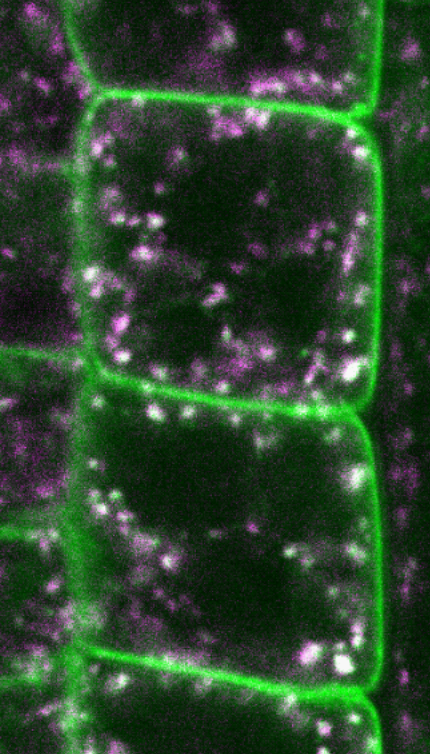Downstream cargoes of endocytosis

Clathrin-mediated endocytosis (CME) of Plasma Membrane (PM) proteins, commonly termed cargo, depends on recognition by so called adaptor proteins. These adaptors can be monomeric or multimeric. the ADAPTOR PROTEIN 2 COMPLEX (AP-2) and the TPLATE adaptor complex (TPC) are two multimeric adaptor complexes required for CME in plants. These adaptor complexes recognize specific linear motifs and post-translational modifications contained in cargo proteins to internalize them and thereby to regulate their trafficking into different pathways. The tyrosine-based motif (Yxxϕ, Y=Tyr, ϕ=bulky hydrophobic amino acid) and the acidic dileucine motif ([D/E]xxxL[L/I] and DxxLL, D=Asp, E=Glu, L=Leu, I=Ile) are motifs that are associated with AP-2. On the other hand, AtEH1/Pan1, a subunit of TPC, interacts with NPF motifs (N=Asn; P=Pro; F=Phe). Secretory Carrier Membrane Protein 5 (SCAMP5), an integral membrane protein, traffics between the PM and the Trans Golgi Network/Early Endosome (TGN/EE). It was shown that TPC, through AtEH1/Pan1, controls SCAMP5 internalization by binding to the double NPF motif in SCAMP5.
Next to linear motifs, Ubiquitination serves as a major recognition signal for the internalization of cargo in plant CME. Recently, we identified that the appendage of the large TPC subunit TASH3, which contains an SH3 domain, functions in recognition of ubiquitinated cargo. The TPC therefore harbors at least two independent cargo recognition domains.
Knockout or knockdown of single TPC subunits causes male sterility and seedling lethality phenotypes, suggesting an essential role for TPC during plant development. The partially functional TPLATE allele, WDXM2, was generated to investigate the role of TPC-dependent endocytosis. We found that a reduced TPC-dependent endocytosis confers a hypersensitivity to very low doses of CLAVATA3 peptide. CLAVATA3, by binding to the CLAVATA1 receptor kinase and via subsequent signaling, functions in shoot apical meristem (SAM) maintenance. The AtEH1/Pan1 TPC subunit could be directly linked to the internalization of the CLAVATA1 receptor kinase, although this one does not possess any clear NPF motifs. Ectopic callose deposition was also observed in the root tip of WDXM2. Ectopic callose deposition is also associated with impaired endocytosis caused by single subunit TPC KO mutations or by disrupting DRP function. The causality of the callose accumulation, which correlates with impaired endocytic function is part of ongoing research at the Van Damme lab.
References:
Van Damme, D. et al. Somatic cytokinesis and pollen maturation in Arabidopsis depend on TPLATE, which has domains similar to coat proteins. Plant Cell. 18, 3502-3518 (2006).
Yperman, K. et al. Distinct EH domains of the endocytic TPLATE complex confer lipid and protein binding. Nat Commun. 12, 3050 (2021).
Wang, J. et al. Conditional destabilization of the TPLATE complex impairs endocytic internalization. Proc Natl Acad Sci U S A.118, e2023456118 (2021).
Grones, P. et al. The endocytic TPLATE complex internalizes ubiquitinated plasma membrane cargo. Nat Plants. 8, 1467-1483 (2022).
Wang, J. et al. TPLATE complex-dependent endocytosis attenuates CLAVATA1 signaling for shoot apical meristem maintenance. EMBO Rep. 24, e54709 (2023).
